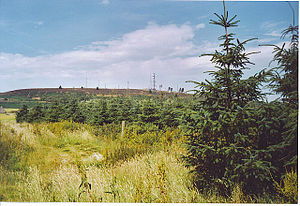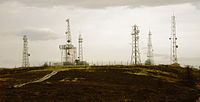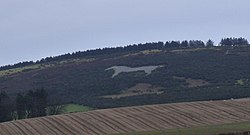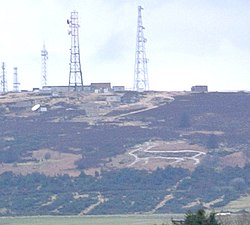Difference between revisions of "Mormond Hill"
(Created page with "{{county|Aberdeen}} Mormond Hill and its antennae Aerial masts on Mormond Hill '''Mormond Hill''...") |
(Infobox etc, images) |
||
| Line 1: | Line 1: | ||
| − | {{county| | + | {{Infobox hill |
| − | + | |name=Mormond Hill | |
| − | + | |county=Aberdeenshire | |
| − | '''Mormond Hill''' is a | + | |range= |
| + | |picture=Mormondhill.jpg | ||
| + | |picture caption=Mormond Hill | ||
| + | |os grid ref=NJ963572 | ||
| + | |latitude=57.605105 | ||
| + | |longitude=-2.06304 | ||
| + | |height=768 feet | ||
| + | |height_m=234 m | ||
| + | }} | ||
| + | '''Mormond Hill''' is a hill of 768 feet in the [[Buchan]] area of [[Aberdeenshire]], the lower part of the county. The name of this hill is from the Gaelic ''A' Mhormhonadh'', meaning 'The great hill (or moor)'. It is indeed a large hill by area, rising prominently out of the low-lying coastal plain. It has two main tops, the higher by a whisker being the western top, but the saddle betwixt them is barely 100 feet lower than either and shallow. | ||
| − | + | The hill stands a little to the south of [[Fraserburgh]]. The villages of [[Strichen]] and [[New Leeds]] can be found at its southern foothills. Running around the southern slope is the [[Formartine and Buchan Way]], a long-distance footpath following a dismantled railway from [[Fraserburgh]] to [[Dyce]] by [[Aberdeen]]. | |
| − | The hill is mentioned in the traditional ballad | + | On the eastern summit stand scatters of disused satellite dishes and masts on top, remnants from Cold War communications systems maintained there by NATO forces. British Telecom has a current presence on the site. |
| − | The | + | |
| + | The hill is mentioned in the traditional ballad ''Mormond Braes''.<ref>'[http://www.rampantscotland.com/songs/blsongs_mormond.htm Mormond Braes]': Traditional Songs on rampantscotland.com</ref> The ballad, in a mixture of Scots and English, with references to '[[Strichen|Strichen toon]]', is about a girl who's lost her lover and is preparing herself to face the world and get another. | ||
| + | [[File:Mormondaerials.jpg|right|thumb|200px|Aerial masts on Mormond Hill]] | ||
The hill is also referenced in the poem ''Farewell to Tarwathie'' by George Scroggie of Strichen, published in 1857, and now better known as the song published in Volume 1 of the Greig–Duncan collection (c. 1909).<ref>{{cite web|url=http://www.justanothertune.com/html/tarwathie.html|title=Song Archeology: From "Earl Douglas' Lament" To "Farewell Angelina", the Long and Twisted History of an Old Tune Family|work=Just another Tune: Songs and their History|author=Jürgen Kloss|accessdate=15 August 2014}}</ref> | The hill is also referenced in the poem ''Farewell to Tarwathie'' by George Scroggie of Strichen, published in 1857, and now better known as the song published in Volume 1 of the Greig–Duncan collection (c. 1909).<ref>{{cite web|url=http://www.justanothertune.com/html/tarwathie.html|title=Song Archeology: From "Earl Douglas' Lament" To "Farewell Angelina", the Long and Twisted History of an Old Tune Family|work=Just another Tune: Songs and their History|author=Jürgen Kloss|accessdate=15 August 2014}}</ref> | ||
| − | == The White Horse and the White Stag == | + | ==The White Horse and the White Stag== |
A white horse is depicted on the side of the hill made from white quartz that has been placed into position to make the shape; its location is a mile north-east of Strichen. The exact date of construction is unknown, but is around the late 1790s. The most widely accepted story for its origin is that the horse was cut by a Captain Fraser, whose horse was shot from under him in a battle in the Flanders Campaign in 1794. A sergeant Henderson, who offered him his own horse, was shot dead in the process. Upon his return Captain Fraser cut the horse as a memorial to the sergeant.<ref name=hows>[http://www.hows.org.uk/personal/hillfigs/morm/mormond.htm "Mormond White Horse and Stag" at hows.org.uk]</ref> | A white horse is depicted on the side of the hill made from white quartz that has been placed into position to make the shape; its location is a mile north-east of Strichen. The exact date of construction is unknown, but is around the late 1790s. The most widely accepted story for its origin is that the horse was cut by a Captain Fraser, whose horse was shot from under him in a battle in the Flanders Campaign in 1794. A sergeant Henderson, who offered him his own horse, was shot dead in the process. Upon his return Captain Fraser cut the horse as a memorial to the sergeant.<ref name=hows>[http://www.hows.org.uk/personal/hillfigs/morm/mormond.htm "Mormond White Horse and Stag" at hows.org.uk]</ref> | ||
| − | The stag, made in 1870, is much larger than the nearby horse, is about 500 | + | The stag, made in 1870, is much larger than the nearby horse, is about 500 feet above sea level. It is 240 feet long and unlike the other figures it is constructed from quartz rocks about five inches in diameter. Tree growth below the figure is increasingly blocking the view. The stag was made by the tenants of the Laird to commemorate his wedding. There is some disagreement as to whether its original form was an outline figure or solid figure. At some stage it has been in outline only, but is now solid. The stag was cleaned in 1939, 1946, 1955, 1984 and in 1994/95.<ref name=hows/> |
| − | + | ||
| − | + | ||
| − | + | ||
| − | + | ||
| − | + | ||
| + | {| | ||
| + | |- | ||
| + | |[[File:Mormond Hill - the horse.jpg|left|thumb|250px|The Horse]] | ||
| + | |[[File:Mormond Hill - the stag.jpg|left|thumb|250px|The Stag]] | ||
| + | |} | ||
==Outside links== | ==Outside links== | ||
| − | + | {{commons}} | |
*Satellite Dish Information- | *Satellite Dish Information- | ||
**[http://www.subbrit.org.uk/rsg/sites/m/mormond_hill NATO and Telecommunications Details] | **[http://www.subbrit.org.uk/rsg/sites/m/mormond_hill NATO and Telecommunications Details] | ||
**[http://www.banthebomb.org/militaryscotland/55.html 'Ban The Bomb' Information on old NATO Communications] | **[http://www.banthebomb.org/militaryscotland/55.html 'Ban The Bomb' Information on old NATO Communications] | ||
| − | + | ==References== | |
| + | {{Reflist}} | ||
| + | |||
[[Category:Hill figures]] | [[Category:Hill figures]] | ||
Latest revision as of 22:21, 19 December 2019
| Mormond Hill | |
| Aberdeenshire | |
|---|---|
 Mormond Hill | |
| Summit: | 768 feet NJ963572 57°36’18"N, 2°3’47"W |
Mormond Hill is a hill of 768 feet in the Buchan area of Aberdeenshire, the lower part of the county. The name of this hill is from the Gaelic A' Mhormhonadh, meaning 'The great hill (or moor)'. It is indeed a large hill by area, rising prominently out of the low-lying coastal plain. It has two main tops, the higher by a whisker being the western top, but the saddle betwixt them is barely 100 feet lower than either and shallow.
The hill stands a little to the south of Fraserburgh. The villages of Strichen and New Leeds can be found at its southern foothills. Running around the southern slope is the Formartine and Buchan Way, a long-distance footpath following a dismantled railway from Fraserburgh to Dyce by Aberdeen.
On the eastern summit stand scatters of disused satellite dishes and masts on top, remnants from Cold War communications systems maintained there by NATO forces. British Telecom has a current presence on the site.
The hill is mentioned in the traditional ballad Mormond Braes.[1] The ballad, in a mixture of Scots and English, with references to 'Strichen toon', is about a girl who's lost her lover and is preparing herself to face the world and get another.
The hill is also referenced in the poem Farewell to Tarwathie by George Scroggie of Strichen, published in 1857, and now better known as the song published in Volume 1 of the Greig–Duncan collection (c. 1909).[2]
The White Horse and the White Stag
A white horse is depicted on the side of the hill made from white quartz that has been placed into position to make the shape; its location is a mile north-east of Strichen. The exact date of construction is unknown, but is around the late 1790s. The most widely accepted story for its origin is that the horse was cut by a Captain Fraser, whose horse was shot from under him in a battle in the Flanders Campaign in 1794. A sergeant Henderson, who offered him his own horse, was shot dead in the process. Upon his return Captain Fraser cut the horse as a memorial to the sergeant.[3]
The stag, made in 1870, is much larger than the nearby horse, is about 500 feet above sea level. It is 240 feet long and unlike the other figures it is constructed from quartz rocks about five inches in diameter. Tree growth below the figure is increasingly blocking the view. The stag was made by the tenants of the Laird to commemorate his wedding. There is some disagreement as to whether its original form was an outline figure or solid figure. At some stage it has been in outline only, but is now solid. The stag was cleaned in 1939, 1946, 1955, 1984 and in 1994/95.[3]
Outside links
| ("Wikimedia Commons" has material about Mormond Hill) |
- Satellite Dish Information-
References
- ↑ 'Mormond Braes': Traditional Songs on rampantscotland.com
- ↑ Jürgen Kloss. "Song Archeology: From "Earl Douglas' Lament" To "Farewell Angelina", the Long and Twisted History of an Old Tune Family". Just another Tune: Songs and their History. http://www.justanothertune.com/html/tarwathie.html. Retrieved 15 August 2014.
- ↑ 3.0 3.1 "Mormond White Horse and Stag" at hows.org.uk


